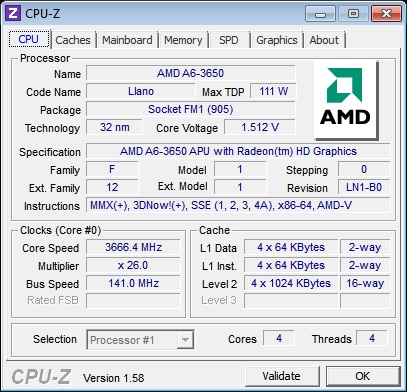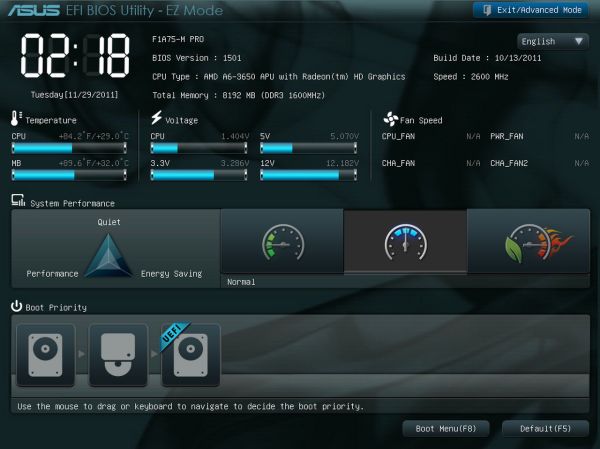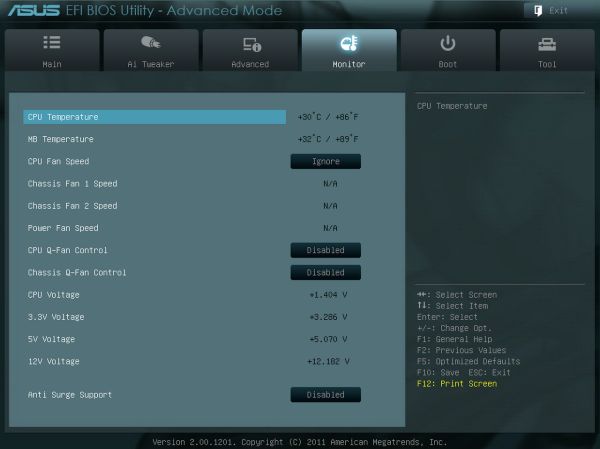ASUS F1A75-M Pro Review - Micro-ATX Llano at $110
by Brendan van Varik on January 22, 2012 2:00 AM EST- Posted in
- Motherboards
- Asus
- Llano
BIOS
As with previous ASUS A75 iterations, our BIOS today is a fully graphical based BIOS - I found it easy to navigate around and find what you are looking for. All of the settings are where you would expect to find them and I feel that ASUS engineers have made this BIOS with ease of use in mind.
The front page of the BIOS contains the basic information of the system along with some voltage readings and temperatures. You can change the boot order here as well by dragging the device which you would like the board to boot from to the front of the list. The three system performance options offer power saving (green), normal (blue), or mildly TPU overclocked (red).
The overclocking section of the BIOS has plenty of settings for you to play around with, including multiplier (with locked APUs only being able to reduce the multiplier), base frequencies, memory strap and voltages either by offset or absolute values. The OC Tuner option does the equivalent of enabling the TPU - under Ai Overclock Tuner, we have some predefined settings for users to enable, assuming their hardware is capable.
Under the monitoring section, you will be able to control three of the four fans, namely the CPU fan and two chassis fans. The fourth fan is a power fan which is not controllable and will always run at full speed.
If you wish to update the BIOS, it is easily done with a USB stick which is formatted to a FAT file system. I was unable to discern noticeable changes between the 1501 BIOS which was used during the review compared to the newest revision (at the time of writing).
Overclocking
If you decide to overclock your system with the automated process in either the BIOS or the software which ASUS provide, the 'OC Tuner', I only got an extra 3 MHz put on to the bus speed, which equates to 78 MHz on the clock speed of the A6-3650 APU (26x100). The voltages remain at stock and the system is stable. The RAM is automatically bumped up to the 1866MHz strap with the correct timings and voltages set which are in the X.M.P profile. Due to the bus being overclocked by 3 MHz, the RAM ends up with a final speed of 1922 MHz with the same timings and 1.65 volts is applied.

When I overclocked the system manually via the BIOS, I was able to achieve a final base clock of 141 MHz at 1.5 V, which gave an overall clock speed of 3666.4 MHz.



















32 Comments
View All Comments
ASUSTechMKT - Monday, January 23, 2012 - link
Have not tested 3870K but tried the 3670K and was easily able to hit to 3.8GHz no APU bus adjustment just multipler. I tested this on -M, -V Pro, -V EVO and -I Deluxe. Make sure though you updated to the latest UEFI to correctly and fully support the K series APUs.ET - Sunday, January 22, 2012 - link
That "Level Up!!" text on the TurboV EVO screen made me think that it would be cool if playing with the BIOS could be made into a game. Give achievements for exploring the BIOS, up the user's hardware hacker level when he changes stuff successfully without making the PC unbootable.Basilisk - Sunday, January 22, 2012 - link
(Here's my chance to look dim.)Looking at the comparison table on the first page, I thought "Oh crud... they dropped eSata on the uATX board." eSata's my fetish, I suppose. Then I read the "Board Features" on "Inside the Box" and did a double-take when it listed "1 x eSATA 6 Gbps", so my hopes rose... until I looked a the pix of the back-panel and the box contents [for brackets].
Alas, I suspect you've a (minor) error and the eSata's missing. Even sadder that it's missing on the ITX board, as external resources and backups become even more valuable (to me) there.
Death666Angel - Sunday, January 22, 2012 - link
The ITX board has eSata on the I/O shield, just look at the review pics at the bottom of this page:http://www.anandtech.com/show/4833/asus-f1a75i-del... (It's between the clear CMOS and DVI and below the 2 red USB ports.)
This mATX board doesn't have eSata on the I/O shield and doesn't provide a PCI bracket, but you can always purchase one of those for $2. :-)
Soulkeeper - Sunday, January 22, 2012 - link
The mini-itx is expensive in part because of the wireless keyboard and wifi.It's worthless for overclocking mostly due to the lack of a higher bclk divider.
To be honest if I wanted a matx fm1 motherboard I'd go with gigabyte's solution.
ASUSTechMKT - Monday, January 23, 2012 - link
our - I Deluxe has been tested to reach the same performance numbers ( APU bus scaling and multipler scaling for K series as the rest of our F1A boards ( -V Pro or -M Pro ). latest UEFI is recommended if you want to have highest potential under both AHCI and IDE ranges.bobbyto34 - Monday, January 23, 2012 - link
thanks a lot for the dpc latency test ! It's very useful for musicians when you want to buy a rig for audio recording !DaneelSE - Monday, January 23, 2012 - link
One promising use for a u-ATX board is using it as a base for a HTPC build. Somehow there seem to be a lack of interest in this arena from reviewers.It would be very interesting to see a real life use scenario benchmarked with power usage. How low can we push a platform in power usage wjhile still performing a few mundane tasks simultaneously.
Just brainstorming here to give an example of possible tasks that would be run at the same time.
1. Watching a DVB-T HD-channel
2. Recording a second channel on a different MUX
3. Transcoding a third recording on low priority
4. Have a internet browser in the background with some predefined work load.
It would be very interesting to see this as a usage case where the reviewer tries to push the power usage down while conserving the end user experience.
I think it would be interesting to see how AMD probably beats Intel until Ivybridge get released and then possibly see a throne shift back and forth a few times.
cjs150 - Monday, January 23, 2012 - link
Sadly just about the only sensible use for Llano is in an HTPC build. (or as low powered laptop which it is very good at).Problem for me is that our cable operator (Virgin) has a TiVo box which lets me watch one channel and record 2 at same time so any HTPC build I do only really needs a mini-itx board (and complete silence!). Hoping that the reviews of Zotac's announcements at CES will take away need for building my own.
Anyway back to a proper HTPC build. The main issues are:
1. Noise. Fans not allowed (except at very low RPM). I want to hear the TV not the HTPC - this is a big problem for me with my Blu-ray player.
2. Sound. There is a big debate as to whether sound is better going through HDMI port or not. Personally I prefer fewer cables to more and my ears are not good enough to tell the difference so sound has tobe routed through HDMI
3. Picture quality: Obviously vital for an HTPC and a big plus for AMD, happy to use integrated graphics here provided (Intel note) frame rate is perfect. Using Integrated graphics frees up a PCI/PCI-E slot for something else.
4. TV card or cards: Dual channel is minimum acceptable.
So for me I can probably built a nice HTPC using mini-itx but if you want to use the full potential of a Micro-Atx you could build one say with 2xdual channel TV cards, separate sound card and GPU - cooling and noise would be an issue though
DaneelSE - Monday, January 23, 2012 - link
I fully understand the limitations and possibilities, and probably am able to work this out by myself.My comment was aimed at how a u-atx review is done. There are a few different target readers.
1. Gamers that want their box as small as possible (Did I hear Zotac Z68-ITX WiFi)
2. HTPC builders that want a all in one solution
3. Small desktop builds where the extra PCIe slots are vital
4. Small server/storage builds
I understand that every review can't cover all bases, but surely a HTPC oriented series of reviews would get a lot of clicks and readers.
Regarding your itemized list
1. good comment and I somehow think consumed power relates to cooling needed. Fan and noise belongs in Case-reviews.
2. Separate review, however the onboard quality should be measured, if nothing else using RMAA
3. I know that Anandtech has reviewers specialized in this area and it should of course be included if IGP is present, if nothing else to indicate when discrete is needed to reach acceptable levels.
4. Agree, wouldn't make sense otherwise, and still debatable if you really need to go as high as u-ATX.